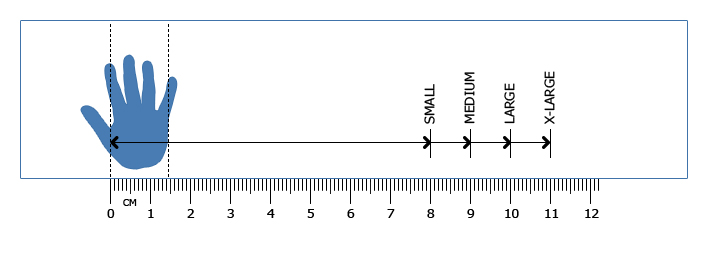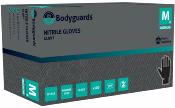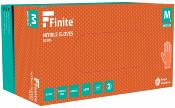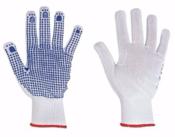PROTECTIVE GLOVE INFORMATIONUnder some circumstances it can become difficult to choose the right Glove for a specific application and as such we have provided the following guide to assist you in making the right choice. Here at NorthSafetyShop we have over 40 years of experience of working within the Personal Protective Equipment Industry. If you are unsure or require any further information please do not hesitate to contact us GLOVE SELECTIONGLOVE TYPE It is initially important to asses the nature/degree of the hazard in each particular application which will then define the risk level Cat 1 Minimal Risk - Temparatures must not exceed 50C Disposable, Examination, Household, General Purpose, Light Duty, Gardening Gloves Cat 2 Intermediate Risk Cut & Puncture Resistant, Mechanical Handling, Re-usable Gloves Cat 3 Serious Risk - Air Temperatures lower than -50C and above 100C Chemical, Electrical, Heat, Cold, Ionising Radiation, Chain Saw Gloves GLOVE MATERIAL The main materials used indepedently or in combination for glove production are: Natural Rubber Latex Polymers Vinyl, Polyurethane, PVA Synthetic Rubbers Nitrile, Neoprene, Butyl, Viton Textile Cotton, Synthetic, Aramid, Steel, High Technology Yarns Film/Foil Polythene, PVA Laminates, Leather Cow, Sheep, Goat, Pig Speciality Chain Mail The most common materials used for Disposable (non-Medical) Gloves are Latex, Vinyl, Nitrile and Polythene Please click on the link opposite for a full breakdown of the pros and cons The most common materials for Examination (Medical) Gloves are Latex, Vinyl, Synthetic, Hybrid, Aloe Vera, Nitrile Please click on the link opposite for a full breakdown of the pros and cons GLOVE SIZING When using Disposable or Examination gloves it is advisable to choose a close fitting size in order to take full advantage of the flexibility, dexterity and comfort of the glove Use the chart below to give an indication of the size required For greater accuracy measure your flattened palm width on your dominant hand using a ruler and then use this measurement to establish your glove size For Glove sizing for Non-Disposable Gloves,please click on the following link <<Glove sizing>>  GLOVE QUALITY AQL is an abbreviation for the Acceptable Quality Level and denotes a statistical measure of the consistency of quality. In other words with a lower AQL batch you will have a higher degree of confidence in the level of quality. AQL 1.5 or lower denotes that the glove is approved for Medical use - often referred to as an Examination Glove AQL 4.0 refers to a non Medical Glove - often referred to as a Disposable Glove Medical Gloves have a very high manufacturing inspection rate and are suitable for Medical Invasive procedures As indicated Cat 3 Gloves must be manufactured and continually assesed under an approved quality management system LATEX ALLERGY This affects a small proportion of the population and occurs due to the naturally occuring proteins in the Natural Rubber Glove causing an Allergenic reaction. In some rare circumstances some chemicals in Non Natural Rubber Gloves can also cause adverse reactions Most at risk are Healthcare Proffessionals and those with pre-existing skin conditions and allergies. Powdered Gloves do help in the donning and removal of gloves, but in some cases can exacerbate an allergenic reaction The risk can be minimised by using Powder Free Gloves, good hygeine before and after use, minimising time of use, cover any breaks of skin prior to use and no use of oil based creams prior to use. There are 2 types of reactions Delayed - where the symptoms are often an itchy swollen red rash Immediate - where the symptoms can vary and include rash, hives, facial swelling, respiratory distress, rhinitus, conjunctivitis and in extremely rare cases anaphylaxis. Seek urgent medical attention in these cases. For more detailed information, please click the following links: << USP Powder Info>>..........<<Safe Removal of Gloves>>...........<<Detailed Allergy Booklet>> CHEMICAL RESISTANT GLOVES CAS (Chemical Abstract Service) the US based world authority for Chemical information, has recently (2015) registered its 100 millionth Chemical Substance, in the 50 years of its existance. Around 75% of these were registered in the last 10 years In many developed countries in the World there are over 25.000 chemicals in regular use throughout industry. It is clearly apparent that the vast majority of Chemicals & Chemical compositions remain untested against Protective Gloves. In order to select the correct glove the following information is required: Nature of the Chemical and/or Chemical combination Type and duration of Protection required ie Full immersion, Splash Protection or Contact Protection Ambient and Process Conditions ie Temperature, Mechanical and/or Thermal Hazards etc In many cases the manufacturer of the Chemical or Branded Chemical Composition will advise which glove to use Under EN374 a Chemical Protective Glove must pass a specific breakthrough time of at least 1-6 chemicals from a group of 18 representative common chemicals. The markings on every Chemical Protective Glove will indicate the number and type of Chemicals have been tested - Please click on the link below for the group of 18 chemicals. This may asssist you. If this does not assist then please click on the link below which outlines a Chemical Glove Guide for 88 common chemicals, If you are still unsure please contact us, as we hold extensive Chemical Permeation/Degradation Data for many other chemicals If no Data exists, we can still in many cases, recommend a suitable Protective Glove based on our experience and knowledge GLOVE STANDARDS Page 10 EN420: General Requirements for Protective Gloves Page 16 EN388: Gloves giving Protection from Mechanical Risks Page 20 EN374: Gloves giving Protection against Chemicals and Micro-organisms Page 28 EN407: Gloves giving Protection from Heat and/or Fire Hazards Page 29 EN511: Gloves giving Protection from Cold Page 32 EN421: Gloves giving Protection Radioactive Contamination & Ionising Radiation Page 36 EN1149: Electrostatic Properties Page 37 EN16350:Electrostatic Props for Protective Gloves used in Explosive Environments Page 40 EN60903:Electrical Insulating Gloves during Live Working Page 44 EN12477:Gloves giving Protection from manual Welding Main Changes now in effect from EN388:2016 Mechanical Hazards include Abrasion Resistance - The abrasion test is done with a new abrasive paper (Klingspor PL31B 180 grit), which is a more reliable quality paper than the one used previously (Oakey Grade F2 100 grit) Some gloves which previously were borderline passes will probably not meet the required standard for the new testing regime. Gloves which previously easily passed a certain level are unlikely to be affected. Cut Resistance - The original test was to use a circular rotating blade (Coupe Method). In some cases, especially in the use of newer high technology yarns, the blade dulled quite quickly and gave an inaccurate result. This test is still used and the result marked as normal. If the test is not performed then in this case X is used to denote this Tear Resistance - No major changes Puncture Resistance - No major changes New Cut Resistance - If during the Coupe Cut Resistance Test, the blade is blunted within 60 passes or if by choice, then the new ISO 13997 straight blade test (TDM-100) is undertaken. The result is designated in the fifth position by the letter A - F or If this test is not performed then a letter X. If both tests are performed then the ISO test takes precedence and the Coupe classification is given for information purposes only. The ISO Test Metthod is considered more accurate, particularly for high cut resistant materials For more information, please refer to the UVEX video link below which summarises the current status very well. New Impact Protection Test - This test is intended for gloves designed for protection against impact. Gloves that do not offer impact protection will not be subjected to this test. For that reason, there are three potential ratings that will be given P (Pass) F (Fail) X (Not Tested) In conclusion Gloves designed for Potection against Mechanical Hazards will now have a a Pictogram with 6 alpha numerical designations rather than the 4 designations under the old standard Main Changes now in effect from EN374:2016 Chemical & Micro-orghanism Hazards include Chemical Resistance - The number of representative test chemicals have increased from 12 to 18 - please see link above The test methods have been modified but the permeation rate is in the same format All gloves which are classed as Chemical Resistant will show the fuming flask icon. This icon will indicate whether the glove is type A, B or C EN374-1/Type A Gloves have passed Level 2 permeation (>30 mins) for at least 6 chemicals from the representative list EN374-1/Type B Gloves have passed Level 2 permeation (>30 mins) for at least 3 chemicals from the representative list EN374-1/Type C Gloves have passed Level 1 permeation (>10 mins) for at least 1 chemical from the representative list The letter which represents the chemical that was tested will be printed under the pictogramm Micro-Organism Resistance - For gloves offering protectiion against Micro-organisms (bacteria and fungi), the biohazard pictogram EN 374-5 is applied. For this the protective glove must be tested according to EN374-2:2013 for leakage proofness. For protection against bacteria, fungi, AND virus, the biohazard pictogram is accompanied with the term “VIRUS“, underneath. For this protective standard, the glove must be tested according to EN374-2:2013 for bacteria and fungi and tested according to ISO16604: 2004 (Method B) using the bacteriophage penetration test. With this standard, protective gloves against micro-organisms can be claimed with or without chemical protection and vice versa. |





